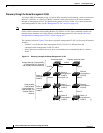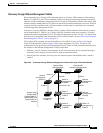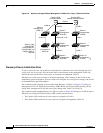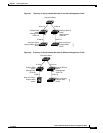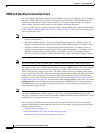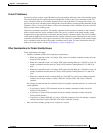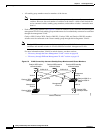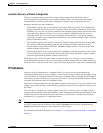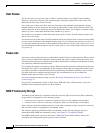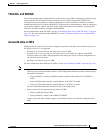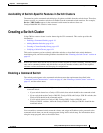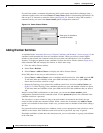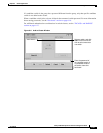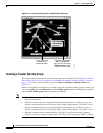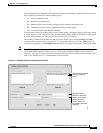
6-16
Catalyst 2950 Desktop Switch Software Configuration Guide
78-14982-01
Chapter 6 Clustering Switches
Planning a Switch Cluster
Host Names
You do not need to assign a host name to either a command switch or an eligible cluster member.
However, a host name assigned to the command switch can help to identify the switch cluster. The
default host name for the switch is Switch.
If a switch joins a cluster and it does not have a host name, the command switch appends a unique
member number to its own host name and assigns it sequentially as each switch joins the cluster. The
number means the order in which the switch was added to the cluster. For example, a command switch
named eng-cluster could name the fifth cluster member eng-cluster-5.
If a switch has a host name, it retains that name when it joins a cluster. It retains that host name even
after it leaves the cluster.
If a switch received its host name from the command switch, was removed from a cluster, was then added
to a new cluster, and kept the same member number (such as 5), the old host name (such as eng-cluster-5)
is overwritten with the host name of the command switch in the new cluster (such as mkg-cluster-5). If
the switch member number changes in the new cluster (such as 3), the switch retains the previous name
(eng-cluster-5).
Passwords
You do not need to assign passwords to an individual switch if it will be a cluster member. When a switch
joins a cluster, it inherits the command-switch password and retains it when it leaves the cluster. If no
command-switch password is configured, the member switch inherits a null password. Member switches
only inherit the command-switch password.
If you change the member-switch password to be different from the command-switch password and save
the change, the switch is not manageable by the command switch until you change the member-switch
password to match the command-switch password. Rebooting the member switch does not revert the
password back to the command-switch password. We recommend that you do not change the
member-switch password after it joins a cluster.
For more information about passwords, see the “Preventing Unauthorized Access to Your Switch”
section on page 7-1.
For password considerations specific to the Catalyst 1900 and Catalyst 2820 switches, refer to the
installation and configuration guides for those switches.
SNMP Community Strings
A member switch inherits the command-switch first read-only (RO) and read-write (RW) community
strings with @esN appended to the community strings:
• command-switch-readonly-community-string@esN, where N is the member-switch number.
• command-switch-readwrite-community-string@esN, where N is the member-switch number.
If the command switch has multiple read-only or read-write community strings, only the first read-only
and read-write strings are propagated to the member switch.
The switches support an unlimited number of community strings and string lengths. For more
information about SNMP and community strings, see Chapter 24, “Configuring SNMP.”
For SNMP considerations specific to the Catalyst 1900 and Catalyst 2820 switches, refer to the
installation and configuration guides specific to those switches.



